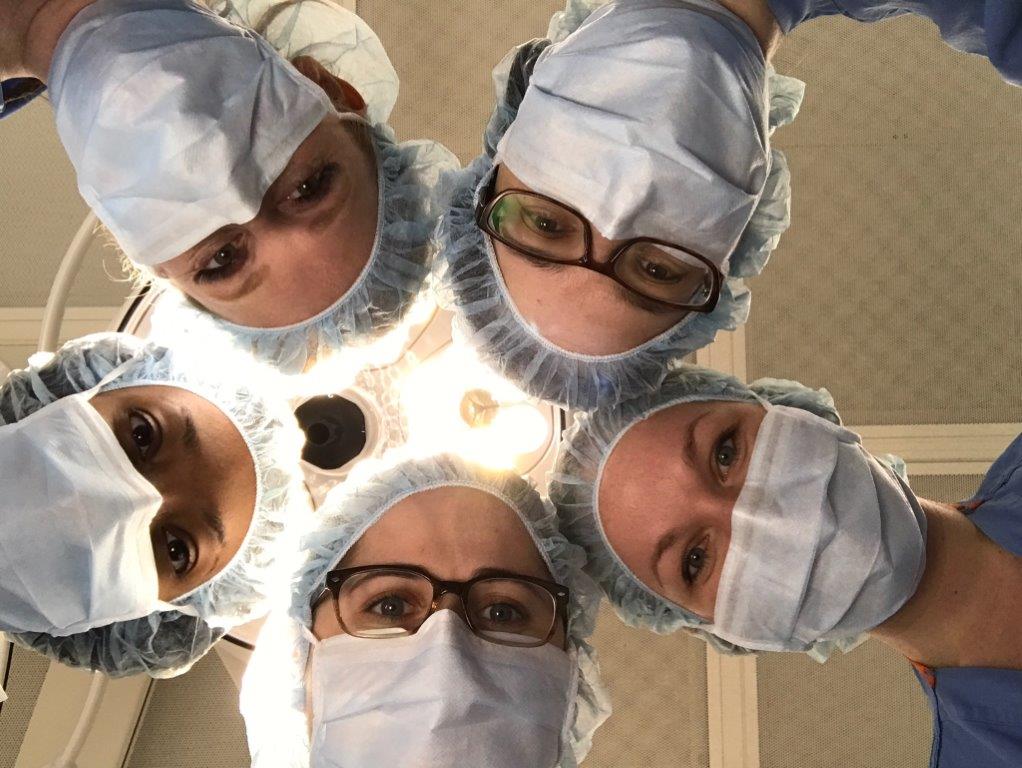First Year (PGY-1)
 In the first year, the residents start with a 2 week Orientation to Labor and Delivery. They will spend the remaining year rotating through the different services in 5 week blocks. They will have 10 weeks on the Obstetrical Service, including inpatient and outpatient obstetrical care, labor and delivery and post-partum care. The intern is expected to perform or be involved with all deliveries and assist or perform all primary cesarean sections. They will also spend 10 weeks on the Obstetrical/Ultrasound Service where they will have an additional 2 days of obstetrical and gynecologic office ultrasound per week as well.
In the first year, the residents start with a 2 week Orientation to Labor and Delivery. They will spend the remaining year rotating through the different services in 5 week blocks. They will have 10 weeks on the Obstetrical Service, including inpatient and outpatient obstetrical care, labor and delivery and post-partum care. The intern is expected to perform or be involved with all deliveries and assist or perform all primary cesarean sections. They will also spend 10 weeks on the Obstetrical/Ultrasound Service where they will have an additional 2 days of obstetrical and gynecologic office ultrasound per week as well.
In our residency we utilize a night float system. Interns will spend 10 weeks on night float providing after-hours care for our patients on labor and delivery and the postpartum floors. They will also spend 10 weeks on benign gynecology, providing both inpatient and outpatient care and participating in surgical procedures. They are introduced to gynecologic oncology with a 5 week rotation. Finally, they spend a 5 week rotation in Reproductive Endocrinology.
In the second year of training the residents are exposed to the Gynecologic Oncology Service for 10 weeks and the Gynecology/REI Service for 10 weeks. During this time they are actively involved in the day-to-day management of these patients and will also participate in the surgical procedures. The PGY2 Residents will also rotate for a total of 10 weeks on the Night Float Service where they will be primarily responsible for covering the Gyn, REI and Gyn Onc patients as well as see consults from the Emergency Room. Second year residents spend 10 weeks on the Obstetrical Service in a supervisory role for the interns as well as performing many of the scheduled repeat cesarean sections. In addition, the second year residents have a 5 week elective rotation and a 5 week OB float rotation, during which they work 10AM-10PM, providing extra support and continuity of care for the Obstetrics team.
In the third year of training the residents spend 10 weeks on the Gynecology Service, where they are involved in more complicated laparoscopic and pelvic reconstructive surgeries. They also spend 5 weeks on Elective. Residents may choose to focus on their Research during the Elective, or they may choose from a variety of services such as, but not limited to: Genetics, Breast, Urogynecology, or an international away rotation. The 3rd year resident spends 10 weeks on the Antepartum/Genetics rotation where they are responsible for all of the antepartum patients that are admitted to the hospital as well as being in charge of the High Risk Obstetric Specialty Clinic. The third year resident will also do 5 week rotation as the OB Float, working 12:00PM-12:00AM in support of the Obstetrics team. Finally, they spend 10 weeks on night float where they act as the chief resident for the hospital.
Fourth Year (PGY-4)
The Chief year is structured with 10 week rotations in Gynecology, Gyn Oncology, and Obstetrics. The chief resident on these services will be responsible for all aspects of the patient care including pre and postoperative care; antepartum, intrapartum and postpartum care; and they will decide how their individual teams will cover surgical cases and specialty clinics for the month. Unique to the PGY-4 experience is a rotation called Gyn Subspecialties. On this rotation, chief residents have the opportunity to solidfy their skills in the oupatient setting through additional experience with the medical management of menopause, minimally invasive surgery consults, REI consults, gynecologic ultrasound and covering GYN and Oncology surgeries. Finally, 10 weeks will be spent on night float where they will be in charge of the resident services and act as a junior attending.
Vacations:
As members of the UUP, residents accrue 3 weeks vacation in each of the first three years and 4 weeks in their Chief year. Vacation is normally requested and approved during the night float or elective rotations to minimize impact on the day services and to allow for more flexiblility in scheduling vacations for the individual resident.

